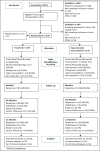Randomised controlled trial of a behaviour change physiotherapy intervention to increase physical activity following hip and knee replacement: the PEP-TALK trial
- PMID: 35641012
- PMCID: PMC9157340
- DOI: 10.1136/bmjopen-2022-061373
Randomised controlled trial of a behaviour change physiotherapy intervention to increase physical activity following hip and knee replacement: the PEP-TALK trial
Abstract
Objective: To test the effectiveness of a behaviour change physiotherapy intervention to increase physical activity compared with usual rehabilitation after total hip replacement (THR) or total knee replacement (TKR).
Design: Multicentre, pragmatic, two-arm, open, randomised controlled, superiority trial.
Setting: National Health Service providers in nine English hospitals.
Participants: 224 individuals aged ≥18 years, undergoing a primary THR or TKR deemed 'moderately inactive' or 'inactive'.
Intervention: Participants received either six, 30 min, weekly, group-based exercise sessions (usual care) or the same six weekly, group-based, exercise sessions each preceded by a 30 min cognitive behaviour discussion group aimed at challenging barriers to physical inactivity following surgery (experimental).
Randomisation and blinding: Initial 75 participants were randomised 1:1 before changing the allocation ratio to 2:1 (experimental:usual care). Allocation was based on minimisation, stratifying on comorbidities, operation type and hospital. There was no blinding.
Main outcome measures: Primary: University of California Los Angeles (UCLA) Activity Score at 12 months. Secondary: 6 and 12-month assessed function, pain, self-efficacy, kinesiophobia, psychological distress and quality of life.
Results: Of the 1254 participants assessed for eligibility, 224 were included (139 experimental: 85 usual care). Mean age was 68.4 years (SD: 8.7), 63% were women, 52% underwent TKR. There was no between-group difference in UCLA score (mean difference: -0.03 (95% CI -0.52 to 0.45, p=0.89)). There were no differences observed in any of the secondary outcomes at 6 or 12 months. There were no important adverse events in either group. The COVID-19 pandemic contributed to the reduced intended sample size (target 260) and reduced intervention compliance.
Conclusions: There is no evidence to suggest attending usual care physiotherapy sessions plus a group-based behaviour change intervention differs to attending usual care physiotherapy alone. As the trial could not reach its intended sample size, nor a proportion of participants receive their intended rehabilitation, this should be interpreted with caution.
Trial registration number: ISRCTN29770908.
Keywords: adult orthopaedics; hip; knee; rheumatology.
© Author(s) (or their employer(s)) 2022. Re-use permitted under CC BY. Published by BMJ.
Conflict of interest statement
Competing interests: None declared.
Figures
References
-
- National Joint Registry . 18Th annual report. NJR 18th annual report 2021.pdf. Available: (njrcentre.org.uk) [Accessed 19 Dec 2020].
Publication types
MeSH terms
Associated data
Grants and funding
LinkOut - more resources
Full Text Sources
Medical
Research Materials
Miscellaneous


